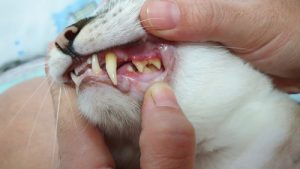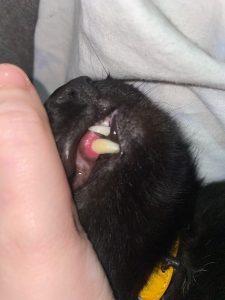Periodontal disease is the most common type of mouth disease in cats. It’s estimated that 50 to 90% of cats over the age of 4 have some form of dental problem. Do not ignore your cat’s red gums, as they can be a sign of a serious disease called stomatitis.
Periodontal disease can be called gingivitis or periodontitis. It’s caused by the build-up of plaque along the gumline, resulting in swollen and red gums. It can easily progress to loss of tooth support. This condition is treatable with proper care. Any age or breed of cat can be affected, but it is most commonly diagnosed in adults or elderly cats.

Overview
What is periodontal disease in cats?
- Periodontal disease combines two diseases: gingivitis and periodontitis.
- Gingivitis is inflammation and infection of the gingiva or gums. It’s considered the earliest stage of periodontal disease.
- Periodontitis is an advanced form of the disease that includes infection of tooth ligaments and loss of tooth support.
- The accumulation of bacteria and food particles in your cat’s mouth leads to a sticky film called plaque. If the plaque is not removed on a regular basis, it will harden and turn into tartar (also called calculus).
- Plaque and tartar accumulate under the gums and on the tooth surfaces, resulting in inflammation and infection of the gums and even the ligaments and bones.
- There is great variation in how the gums react to plaque. Some cats accumulate plaque with little gum reaction, while others have severe reactions.
- Left untreated, bacterial infection of the gum pocket will always progress into loss of tooth support (periodontitis). This causes pain, bone destruction, and tooth loss.
- Bacteria can enter the bloodstream through severe inflammation, bleeding gums, and tooth loss, causing infection or inflammation throughout the body.
Symptoms
Signs of periodontal disease in cats
Signs of cat periodontal disease include:
- Yellow, brown, or grey buildup on teeth (plaque and tartar)
- Bad breath
- Red gums (especially on the cheek-facing side)
- Drooling and/or blood in the saliva
- Signs of pain: pawing at the face, reduced appetite, drooling, changes in behaviour
- Difficulty eating or dropping food

Risk
Are some cats more at risk of periodontal disease than others?
Any cat, regardless of breed, sex, or age, can develop this condition.
There are a few risk factors:
- Genetics
- Old age
- Preference for soft foods
- Crowded teeth, commonly seen in short-faced breeds such as Himalayan
- Misaligned teeth (malocclusions)
- Cats with concurrent systemic problems, such as:
- Infectious diseases (like feline leukaemia FeLV, feline immunodeficiency virus FIV)
- Stomatitis
- Diabetes mellitus
- Kidney disease
- Eosinophilic granuloma complex
Diagnosis
How is periodontal disease diagnosed in cats?
Vets usually diagnose periodontal disease based on the following:
- History taking: changes and problems you notice as an owner
- Physical examination: checking the mouth and teeth, usually under sedation. A dental probing instrument can be used to allow further assessment.
- Mouth radiographs (X-rays): to look for any damage to the tooth roots and other supporting structures
- Urine and blood tests: to look for any underlying disease
Vet treatment
What’s the treatment for periodontal disease in cats?
Treatment will depend on the cause of the disease.
- The first step is to remove plaque and tartar from your cat’s teeth under anaesthesia.
- Then your vet will treat any other causes related to the disease. This can include:
- Tooth extractions
- Antibiotics
- Anti-inflammatories
- Antiseptic gum gels
- Bone grafting and/or guided tissue regeneration. In some cases, this may be an option. It usually requires a specialist in veterinary dentistry to do it.
- Afterwards, continued oral hygiene at home is essential.
Home treatment
How to help your cat with periodontal disease
After your cat has professional dental care at your vet practice, it’s vital that you continue to keep their teeth clean at home to minimise plaque buildup.
Here are some examples in order of effectiveness:
- Brush your cat’s teeth: ideally once a day, but at least once every 3-4 days.
- Wipe their teeth daily with a rough gauze or a finger pad
- Provide dental prescription food. Hill’s Prescription Diet Dental Care t/d is a good option since it reduces plaque, stain, and tartar buildup and helps clean up the gum line.
- Add dry kibble to their meals
- Apply antiseptic gels or rinses
- Add liquid or food supplements to their water or food
There is no liquid or supplement that will remove tartar on its own without toothbrushing.
Our Joii vets are available 24 hours a day, call us now for advice about oral hygiene in cats.
Prevention
How to prevent periodontal disease in cats
In most animals, periodontal disease can be prevented.
Plaque must be kept from building up on teeth.
As mentioned above, home oral hygiene is vital.
Besides brushing, professional cleanings under anaesthesia are often needed since brushing is such a difficult task.
Some animals require this every year or so.
When to worry
When to worry if your cat has periodontal disease
If your cat shows any of the following signs, call your vet:
- Pawing at the face
- Drooling saliva
- Dropping food
- Not eating
- Not improving despite treatment
Call us at Joii if you need help with:
- How to improve your cat’s oral hygiene
- How to brush your cat’s teeth
- Changing their food
- Identifying pain in your cat








